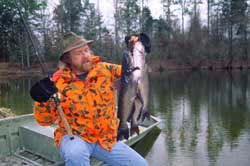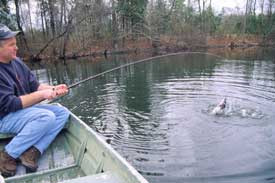
 It was a polar afternoon. A friend, Alex Hinson, and I were catfishing in a small farm pond.
It was a polar afternoon. A friend, Alex Hinson, and I were catfishing in a small farm pond.
I 'd done it once before — fishing for pond catfish in the dead of winter, that is. Nearly thirty years have passed, but I remember vividly the enormous stringer of channel cats I caught that wintry day. I was twelve and hungry for some fishing, so I grabbed a rod and reel, and a box of chicken livers from my grandmother's freezer. Soon, I was standing in snow on the bank of my uncle's fish pond, casting to the big cats that lurked therein, but never really expecting to catch one.
To my surprise, the catfish were extraordinarily cooperative. I'd cast a bait into deep water by the dam, and before it hit bottom, a channel cat would take it. One after another, I hauled them in. I'd caught plenty of catfish before, including quite a few jumbos, but nothing like that afternoon. In under two hours, I had 20 fat cats croaking atop the snow.
I shared the story with Alex one day, who suggested we plan another winter junket immediately. And so, within the week, we found ourselves sitting in a jon boat over a deep hole in the pond, dropping liver-baited hooks into the murky depths. Before each bait touched down, a sassy channel cat would have it. Alex caught a five-pounder, then its twin. I caught several over three. Twenty-three fell prey to our tactics.
Many catfishermen still labor under the false impression that catfish don't bite in winter. That's not true. Take channel cats, for instance. The experiences I outlined above show the exciting potential for catching these fighters during cold months. Even more amazing is the fact that channel cats are now common targets for ice-fishermen in northern states. Despite popular misconceptions, they don't lay in the mud and sulk when it's cold. They actively hunt food and bite readily even when lakes and rivers are frozen.
If it's eating-size cats you're after, head straight for the nearest farm pond. Many are stocked with channel cats, and despite what you may have thought, winter is the best season for catching them in these environs. You can expect good action December through February, in the far North, in the deep South and all points between. Expect the best pond catfishing, however, when the water temperature is between 40 and 55 degrees.
 Start by asking the pond owner to point out the deepest hole in the pond. During cold weather, that's where most cats will be. Fish from a boat if you can, lowering a bait straight down into the hole. My typical rig consists of a 5/0 Daiichi octopus hook, with a couple of split shot crimped on the line a foot above. When it reaches the bottom, I turn the reel handle a few cranks so the bait is a foot or so above the substrate where cats can better detect it. When bank fishing, I use a 1-ounce Rubbercor sinker instead of split shoot and add a small cigar-shaped crappie cork on the line between the hook and sinker to float the bait just off the bottom.
Start by asking the pond owner to point out the deepest hole in the pond. During cold weather, that's where most cats will be. Fish from a boat if you can, lowering a bait straight down into the hole. My typical rig consists of a 5/0 Daiichi octopus hook, with a couple of split shot crimped on the line a foot above. When it reaches the bottom, I turn the reel handle a few cranks so the bait is a foot or so above the substrate where cats can better detect it. When bank fishing, I use a 1-ounce Rubbercor sinker instead of split shoot and add a small cigar-shaped crappie cork on the line between the hook and sinker to float the bait just off the bottom.
Chicken liver is a top bait in this situation. Cats quickly zero in on the scent and taste of poultry blood dissolving from the tissue. Some catters prefer frozen livers, because they stay on the hook better, but fresh liver has more cat-attracting qualities. Weave your hook through each piece several times, and you shouldn't have too much problem keeping it on.
Don't sit in one spot too long. If a cat is nearby, you'll have a bite before 15 minutes passes. If you don't, move a short distance and try again. If catfish are biting, the action may end abruptly after you've caught a few fish. Once again, it's time to move and try another location.
Of course, when you're fishing for cats in winter, it pays to keep moving anyway, just so you can keep warm. This is not a sport for anglers who detest the cold. You'll get chilly out there, even when you're wearing the proper clothing. Your teeth will chatter, and your hands and feet will feel like popsicles.
Nice thing is, when the cats start biting, that frigid feeling disappears. Nothing in the world warms you quicker than battling a rod-bending cat.
- 10107 views

